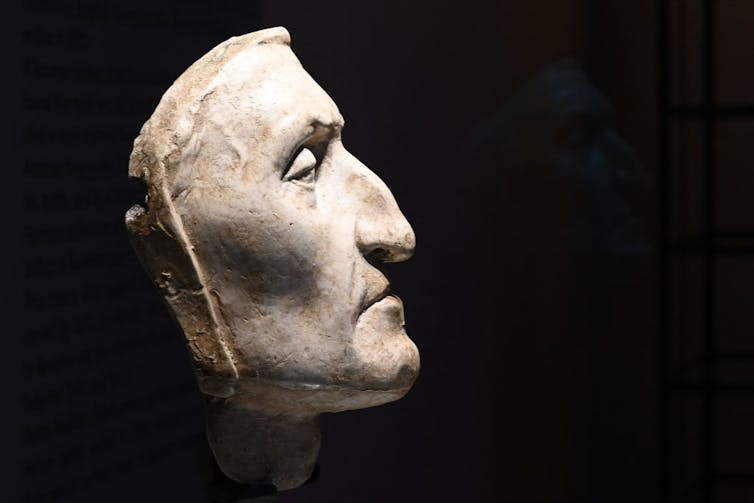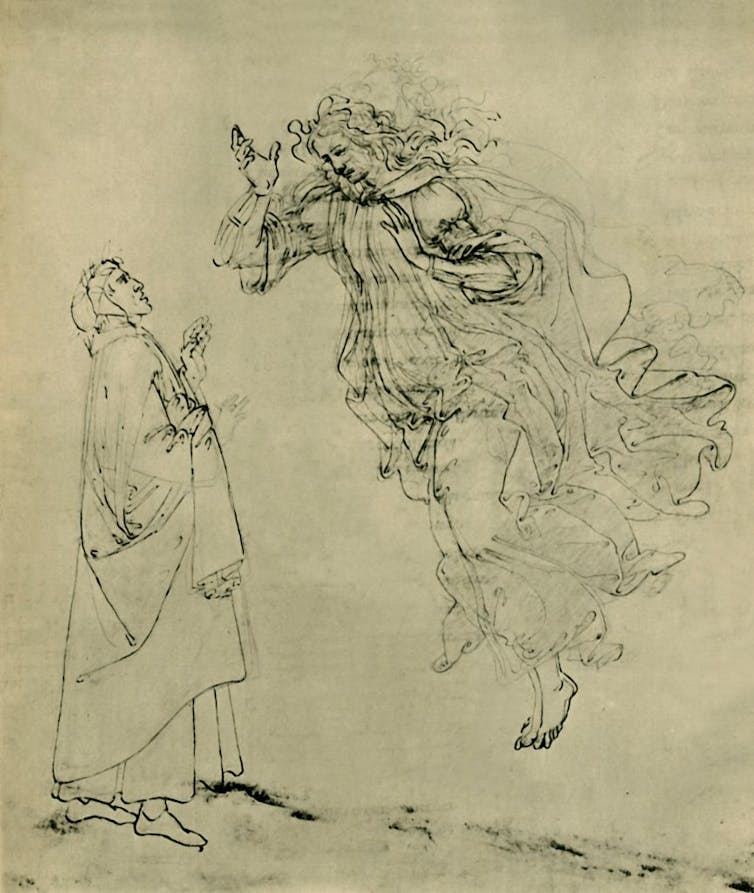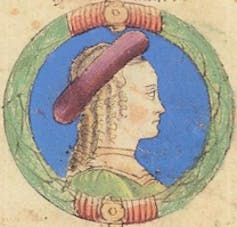The women who appear in Dante's 'Divine Comedy' are finally getting their due, 700 years later
- Written by Laura Ingallinella, Mellon Postdoctoral Fellow in Italian Studies and English, Wellesley College
When Dante Alighieri died 700 years ago, on Sept. 14, 1321, he had just put his final flourishes on the “Divine Comedy[1],” a monumental poem that would inspire readers for centuries.
The “Divine Comedy” follows the journey of a pilgrim across the three realms of the Christian afterlife – hell, purgatory and paradise. There, he encounters a variety of characters, many of whom are based on real people Dante had met or heard of during his life.
One of them is a woman named Sapia Salvani. Sapia meets Dante and his first guide, Virgil, on the second terrace of purgatory. She tells the two how her fate in the afterlife was sealed – how she stood at the window of her family’s castle and, with troops gathering in the distance, prayed for her own city, Siena, to fall. Despite their advantage, the Sienese were slaughtered – including Sapia’s nephew, whose head was paraded around Siena on a pike.
Sapia, however, felt triumphant. According to Dante and medieval theologians, she had fallen prey to one of the seven capital vices, “invidia[2],” or envy.
The portrayal of Sapia in the “Divine Comedy” is imbued with political implications, many of which boil down to the fact that Dante blamed the violence of his time on those who turned against their communities out of arrogance and greed.
But the real Sapia was even more interesting than Dante would have you believe. Documentary sources[3] reveal that she was a committed philanthropist: With her husband, she founded a hospice for the poor on the Via Francigena, a pilgrimage route to Rome. Five years after witnessing the fall of Siena, she donated all her assets to this hospice.
Sapia is one among many characters from the “Divine Comedy” that deserve to be known beyond – and not just because of – what Dante decided to say about them in his poem. With my students at Wellesley College[4], I’m reviving the real stories behind the characters of Dante’s masterpiece and making them available to everyone on Wikipedia. And it was especially important for us to start with his female characters.
Why women?
Among the 600 characters appearing in the “Divine Comedy,” women are the least likely to appear in the historical record. Medieval authors tended to write biased accounts of women’s lives, motives and aspirations[5] – if not ignore them altogether. As a result, the “Divine Comedy” is often the only accessible source of information on these women.
At the same time, Dante’s treatment of women isn’t free from misogyny. Scholars such as Victoria Kirkham[6], Marianne Shapiro[7] and Teodolinda Barolini[8] have shown that Dante relished turning women into metaphors, from pious maidens to villainesses capable of bringing dynasties to their knees.
 A recreation of Dante Alighieri’s death mask at the Palazzo Vecchio in Florence, Italy.
Vincenzo Pinto/AFP via Getty Images[9]
A recreation of Dante Alighieri’s death mask at the Palazzo Vecchio in Florence, Italy.
Vincenzo Pinto/AFP via Getty Images[9]
For this reason, fuller pictures of Dante’s women have been elusive. As a researcher, you’re lucky if you can come across a contemporary who supported or built upon Dante’s tangled reinvention, or documents in which the woman in question is mentioned as mother, wife or daughter.
Putting together the pieces on Wikipedia
The more my students asked me about the women in the poem, the more I wondered: What if we found a way to tell everyone their stories? So I approached Wiki Education[10], a nonprofit that fosters the collaboration between higher education and Wikipedia, to see if they would partner with me and my students. They agreed.
The recipe behind Wikipedia’s two decades of success is its stunning simplicity: an open encyclopedia written and maintained by a worldwide community of volunteers who draft, edit and monitor its free content.
Wikipedia’s status as a crowdsourced work is one of its greatest strengths, but it’s also its greatest weakness in that it reflects the world’s systemic flaws[11]: The vast majority of Wikipedia contributors identify as male[12].
In 2014, only 15.5% of Wikipedia’s biographies in English[13] were about women. By 2021, that number had risen to 18.1%[14], but that was after more than six years of sustained efforts[15] aimed at bolstering[16] the representation of women on Wikipedia by creating new entries and referencing scholarship authored by women.
Knowledge as advocacy
For my students, researching and composing Wikipedia entries on Dante’s characters doubled as advocacy.
Writing for Wikipedia is different from writing an essay. You must be unbiased, avoid personal flourishes and always back your statements with external references. Rather than producing an argument, you offer readers the tools to build an argument of their own.
And yet the very act of writing an entry about a person does advance a specific argument: that their life is worth being the focus of attention, rather than an easily forgettable name in the backdrop of a grand narrative. This choice is a radical one. It’s an affirmation that someone possesses historical value beyond the fact that they provided a spark of inspiration to an author.
 Beatrice Portinari guiding Dante through paradise in a drawing by Sandro Botticelli.
The Print Collector/Heritage Images via Getty Images[17]
Beatrice Portinari guiding Dante through paradise in a drawing by Sandro Botticelli.
The Print Collector/Heritage Images via Getty Images[17]
Pursuing this goal was not without challenges; it could be difficult to maintain an unbiased tone while telling stories of violence and abuse.
That was the case with Ghisolabella Caccianemico[18], a young woman from Bologna sold into sexual slavery by her brother, Venèdico, who hoped to form an alliance with a neighboring marquis. Dante told his readers a “filthy tale” that would make them indignant. In it, Ghisolabella is a silent victim surrounded by men.
However, we turned Ghisolabella into the subject of her story, threading the fine line between giving a starkly objective account of the violence she suffered and preserving her dignity.
“Ghisolabella’s extramarital relation[s] with the marquis, though against her will, was ruinous to her status,” wrote my student[19], citing early 20th-century scholars who canvassed the archives of Bologna for evidence on Ghisolabella.
“Dante’s inclusion of Ghisolabella,” she added, “eternalizes Venèdico’s sin.”
Turning the tables on Dante
Researching these women also turned into an opportunity to upend Dante’s personal views.
Take Beatrice d’Este[20], a noblewoman Dante criticizes for marrying again after her first husband died. Dante was outraged by widows who dared to remarry instead of remaining forever faithful to their late spouses. Not everyone, however, agreed with his defamation of Beatrice.
 Beatrice d'Este.
Wikimedia Commons[21]
Beatrice d'Este.
Wikimedia Commons[21]
To tell Beatrice’s story, my student just needed to look into the right places – namely, an exceptional article by Deborah W. Parker, who put Dante’s treatment of Beatrice into context[22].
Parker explains how Beatrice was likely pressured into her second marriage and tried to negotiate her place in a world that subjected her to slander. By having the family crests of her two husbands carved side by side on her tomb, she made a pregnant statement about her identity and allegiances.
[You’re smart and curious about the world. So are The Conversation’s authors and editors. You can read us daily by subscribing to our newsletter[23].]
Thanks to our work, in addition to Ghisolabella and Beatrice d’Este, there are now over a dozen biographies of these women on Wikipedia: Alagia Fieschi[24], Cianghella della Tosa[25], Constance of Sicily[26], Cunizza da Romano[27], Gaia da Camino[28], Giovanna da Montefeltro[29], Gualdrada Berti[30], Joanna of Gallura[31], Matelda[32], Nella Donati[33], Pia de’ Tolomei[34], Piccarda Donati[35] and Sapia Salvani[36]. They join Beatrice Portinari[37] and Francesca da Rimini[38], the only two historical women from the “Divine Comedy” who had acceptable entries on Wikipedia prior to our work.
As feminist theorist Sara Ahmed writes in “Living a Feminist Life[39],” “citations can be feminist bricks: they are the materials through which, from which, we create our dwellings.”
One brick at a time – one page, revision or added reference at a time – Wikipedians can broaden our understanding of the past, centering women’s stories in a world that has long edited them out.
References
- ^ Divine Comedy (digitaldante.columbia.edu)
- ^ invidia (plato.stanford.edu)
- ^ Documentary sources (en.wikipedia.org)
- ^ With my students at Wellesley College (scholar.google.com)
- ^ biased accounts of women’s lives, motives and aspirations (doi.org)
- ^ Victoria Kirkham (www.jstor.org)
- ^ Marianne Shapiro (www.jstor.org)
- ^ Teodolinda Barolini (www.jstor.org)
- ^ Vincenzo Pinto/AFP via Getty Images (www.gettyimages.com)
- ^ Wiki Education (wikiedu.org)
- ^ in that it reflects the world’s systemic flaws (theconversation.com)
- ^ identify as male (meta.wikimedia.org)
- ^ only 15.5% of Wikipedia’s biographies in English (arxiv.org)
- ^ had risen to 18.1% (humaniki.wmcloud.org)
- ^ more than six years of sustained efforts (en.wikipedia.org)
- ^ aimed at bolstering (en.wikipedia.org)
- ^ The Print Collector/Heritage Images via Getty Images (www.gettyimages.com)
- ^ Ghisolabella Caccianemico (en.wikipedia.org)
- ^ wrote my student (en.wikipedia.org)
- ^ Beatrice d’Este (en.wikipedia.org)
- ^ Wikimedia Commons (commons.wikimedia.org)
- ^ who put Dante’s treatment of Beatrice into context (www.jstor.org)
- ^ You can read us daily by subscribing to our newsletter (theconversation.com)
- ^ Alagia Fieschi (en.wikipedia.org)
- ^ Cianghella della Tosa (en.wikipedia.org)
- ^ Constance of Sicily (en.wikipedia.org)
- ^ Cunizza da Romano (en.wikipedia.org)
- ^ Gaia da Camino (en.wikipedia.org)
- ^ Giovanna da Montefeltro (en.wikipedia.org)
- ^ Gualdrada Berti (en.wikipedia.org)
- ^ Joanna of Gallura (en.wikipedia.org)
- ^ Matelda (en.wikipedia.org)
- ^ Nella Donati (en.wikipedia.org)
- ^ Pia de’ Tolomei (en.wikipedia.org)
- ^ Piccarda Donati (en.wikipedia.org)
- ^ Sapia Salvani (en.wikipedia.org)
- ^ Beatrice Portinari (en.wikipedia.org)
- ^ Francesca da Rimini (en.wikipedia.org)
- ^ Living a Feminist Life (www.dukeupress.edu)
Authors: Laura Ingallinella, Mellon Postdoctoral Fellow in Italian Studies and English, Wellesley College

